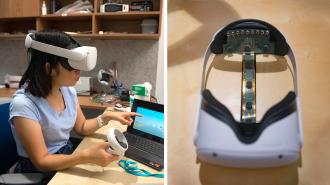Texas researchers have found a way to modify the most popular commercial VR headset to record brain activity. They hope this mod will create a powerful research tool that will make it easier to learn what’s going on in people’s brains while they’re in virtual worlds.
The challenge: VR is no longer just a way for people who are into gaming to get into gaming — today, you can strap on a VR headset to train for a job, undergo immersive psychotherapy, or remotely control a humanoid robot.
In many of these applications, it’d be useful to be able to monitor a person’s brain activity while they’re using a VR headset. This could help doctors determine whether a therapy is working, for example, or let airlines measure the mental load of pilots training in VR.
While VR headsets equipped with brainwave-reading EEG sensors do exist, they’re typically rare and expensive. Wearing an EEG cap or individual electrodes at the same time as a VR set, meanwhile, can be uncomfortable, especially for an extended period of time.
“Our sponge-electrode-integrated VR headset is user-friendly and easy to set up.”
Li et al. (2023)
What’s new? Researchers at the University of Texas at Austin have modified a Meta Quest 2 headset, which costs about $300, with an EEG device and soft, spongy electrodes, which they developed out of a conductive material called “PEDOT:PSS.”
“Our sponge-electrode-integrated VR headset is user-friendly and easy to set up, marking a step toward future reliable, comfortable, and reusable VR-EEG technology,” they write in a paper, published in Soft Science.
Testing time: To see whether the modified VR headset could accurately record brain activity, the researchers had four participants wear it while opening or closing their eyes on command. There is typically an increase in alpha waves in a person’s brain when their eyes are closed, and the researchers could see this increase in the EEG data recorded by their headset.
They also had the participants wear the headset while playing a custom game designed to trigger a type of brain activity that occurs when a person is preparing for an event. As hoped, the researchers were able to see this activity in the recorded EEG data, too.
“Our technology enables us to get better measurements of how the brain is reacting to virtual reality.”
Nanshu Lu
Looking ahead: The UT Austin team has started filing the paperwork to patent their tech and say they’d be open to working with VR companies to incorporate it into their systems. They don’t say what it costs to make the soft electrodes, so it’s not clear exactly how much consumers or professionals should expect to pay for a modified VR headset.
For now, the researchers plan to use the system to see what happens in people’s brains as they remotely monitor dog-like delivery robots on the UT campus. The goal of this is to determine what sort of mental load this might place on people with that job in the future.
“Virtual reality is so much more immersive than just doing something on a big screen,” said lead researcher Nanshu Lu. “It gives the user a more realistic experience, and our technology enables us to get better measurements of how the brain is reacting to that environment.”
We’d love to hear from you! If you have a comment about this article or if you have a tip for a future Freethink story, please email us at tips@freethink.com.
